One of the key functions and unique selling points of the Drobo 5D3 is the hot swappable capabilities. This means you can actually continue to use the 5D3 while you replace a drive.
To mirror a real world drive replacement scenario. We filed the Drobo 5D3 DAS up with several TB's of data and while the unit was on, we removed one of the 4TB drives to replace it with a higher capacity 6TB drive from Toshiba.
First we loaded the Drobo Dashboard software and made a quick check of the drive configuration and the health of the mSATA cache drive. All looked fine. We started the copy of 123GB of files.
While data was copying we removed the top drive and the copying process continued with a warning alert over the Data protection process. You cannot remove another drive at this stage.
We inserted the 6TB drive and within 30 seconds it registered in the Drobo Dashboard – the Data protection process continued, as did the copying of the files in the background.
The data protection time would fluctuate a little, moving between 10-20 minutes. Clearly copying data to the live RAID while it was setting up the new 6TB drive (and changing the RAID partition) was causing a little bit of an overhead. Still overall the copying speed didn't drop too much – likely aided by the mSATA cache drive too.
When the Drobo had finished the setup (took around 15 minutes in total), the alert disappeared and the new configuration was shown in the icon breakdown at the right.
I checked the capacity configuration page and noticed that the size of the RAID configuration did not increase. Instead 1.81TB (which is the difference between the 4TB drive and the new 6TB drive) was put into the blue bar marked as ‘Reserved for expansion'. Checking online there is little to be found to explain exactly how this works.
I subsequently asked my contact for Drobo (Bernd Peeters) and he explained how this works in more detail.
There are 2 factors that come into play when inserting new drives:
The capacity of the new drive(s).
The level of redundancy that is used.
1 the capacity of the new drives
If you are entering a new drive that is smaller than the biggest drive that is currently in the system it will immediately increase the usable capacity accordingly.
If you are entering a new drive that is bigger than the biggest drive that is currently in the system it will reserve the extra capacity for expansion which will initially not result in larger usable capacity.
2 the level of redundancy.
If you are using single drive redundancy (default setting) and you wish to increase the usable capacity with drives that are larger than the existing drives in the Drobo you will need to add 2 drives in order to do so.
If you are using dual drive redundancy and you wish to increase the usable capacity with drives that are larger than the existing drives in the Drobo you will need to add 3 drives in order to do so.
This is also why Drobo added the capacity calculator: http://www.drobo.com/storage-products/capacity-calculator/.
This leads to two rules of thumb that can be applied for figuring out that why you would only see “used for protection” or “used for protection + reserved for expansion”:
Used for protection = capacity of biggest drive, when there are multiple drives that are consider the biggest capacity drives (single redundancy will require the largest 2 drives to be the same capacity, and dual redundancy requires the largest 3 drives to be of the same capacity)
OR
Used for protection + Reserved for expansion = capacity of biggest drive, when there is a single drive that is considered the biggest capacity drive for single redundancy OR it is the combined capacity of the two largest capacity drives if ‘only’ two drives are considered the biggest capacity drives for dual redundancy.
The story is slightly different if you still have a spare drive and you add a larger drive that what exists in the system. In that case depending on whether its single or dual redundancy you need to subtract the capacity of the biggest 1 or 2 drives to calculate the raw usable capacity but it will always increase usable capacity.
Existing: 6+6+6 = 18TB
Single redundancy: 6+6+6 = 12TB
Dual redundancy = 6+6+6 = 6TB
Add an 8TB HDD
Single redundancy: 6+6+6+8 = 18TB usable (6TB increase in usable capacity, 2TB reserved for expansion + 6TB used for protection)
Dual redundancy: 6+6+6+8 = 12TB usable (6TB increase in usable capacity, 2TB reserved for expansion + 12TB used for protection)
The 2TB still relates to the difference between the other largest drives.
 KitGuru KitGuru.net – Tech News | Hardware News | Hardware Reviews | IOS | Mobile | Gaming | Graphics Cards
KitGuru KitGuru.net – Tech News | Hardware News | Hardware Reviews | IOS | Mobile | Gaming | Graphics Cards


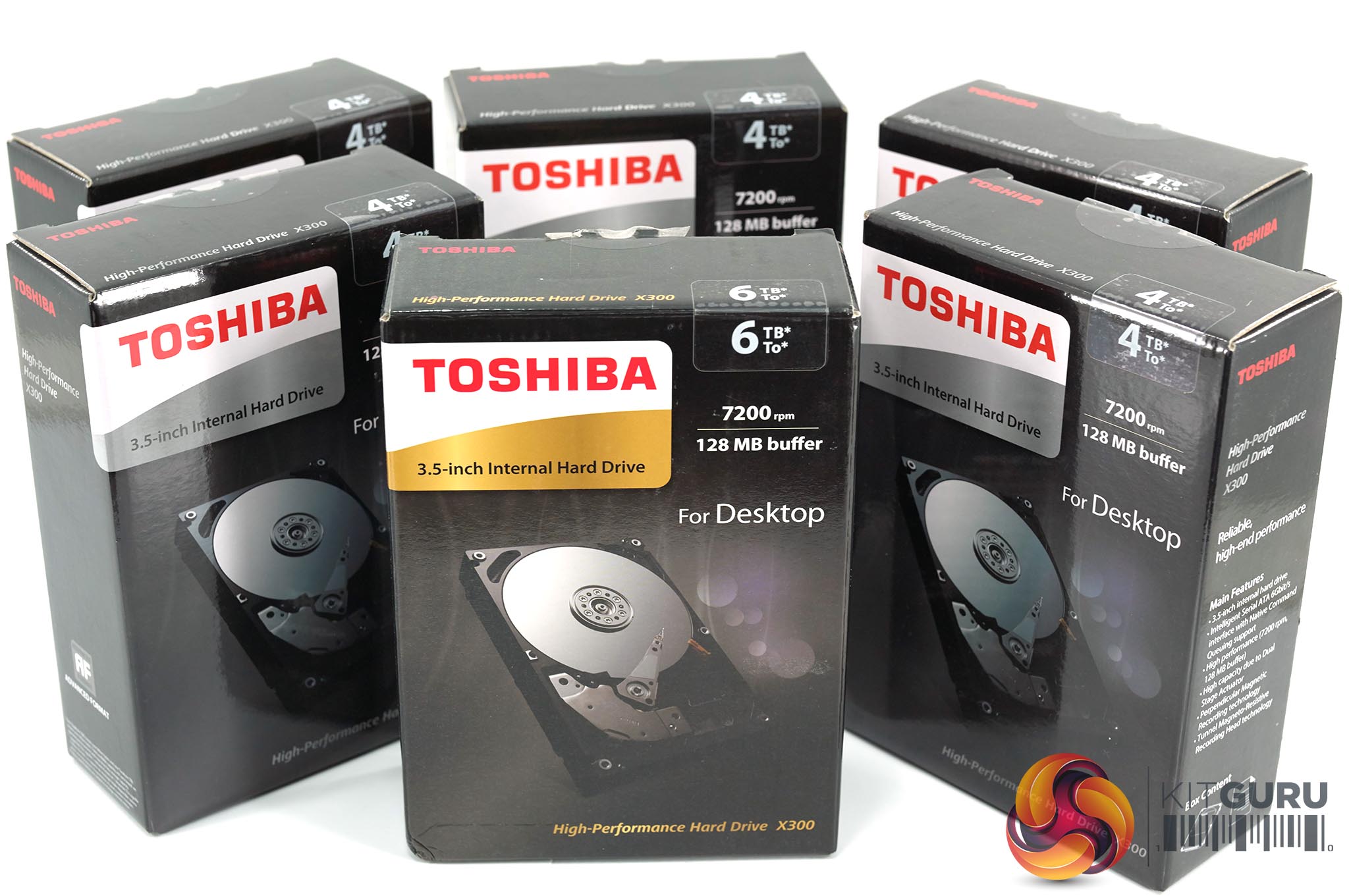
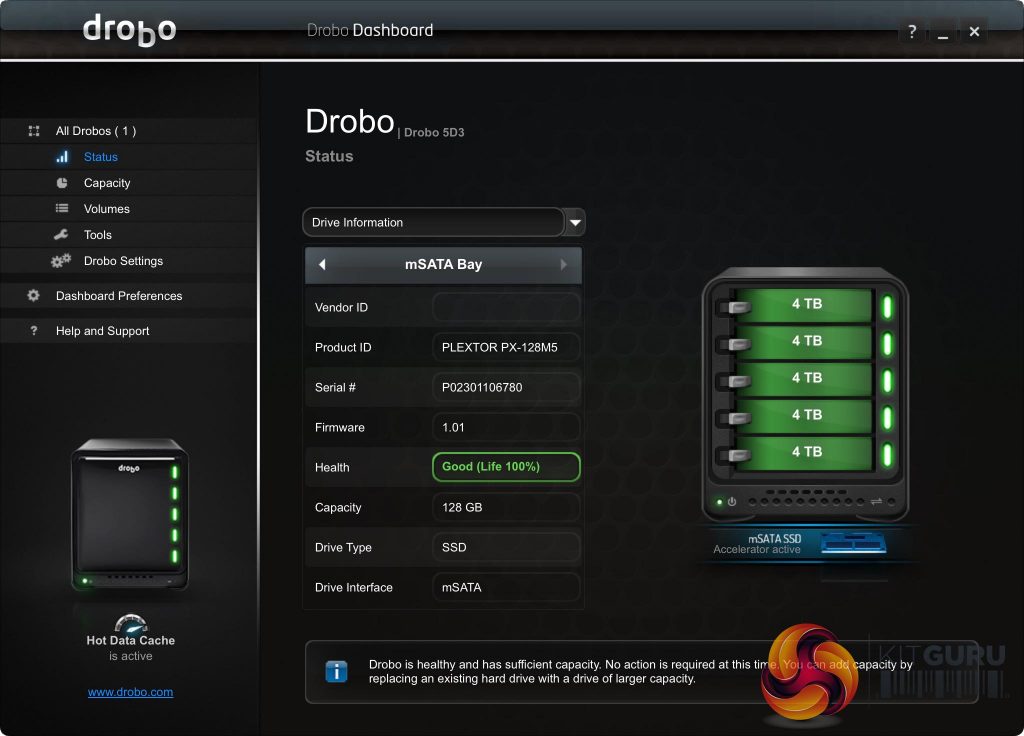
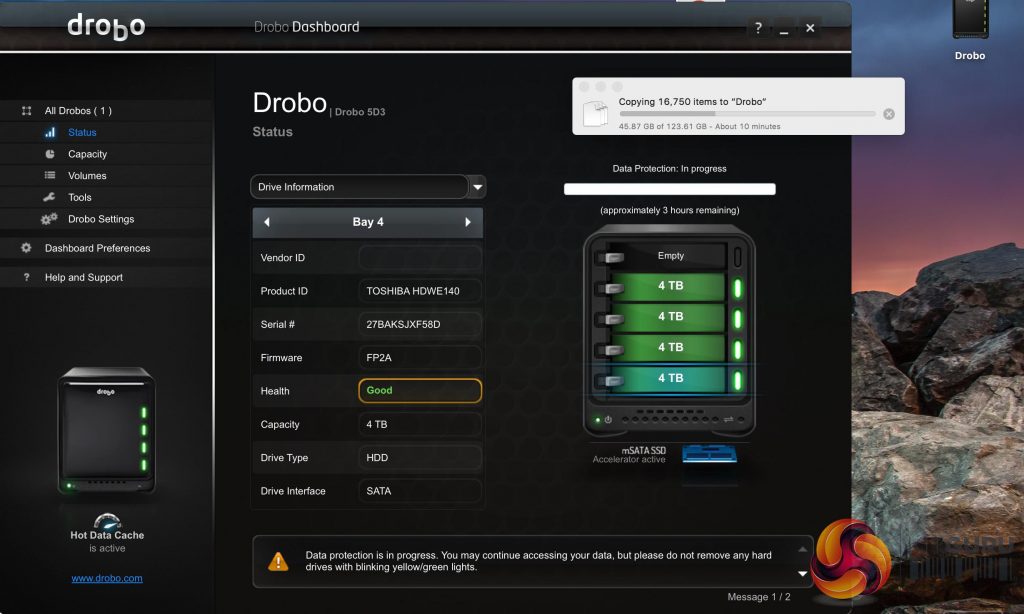
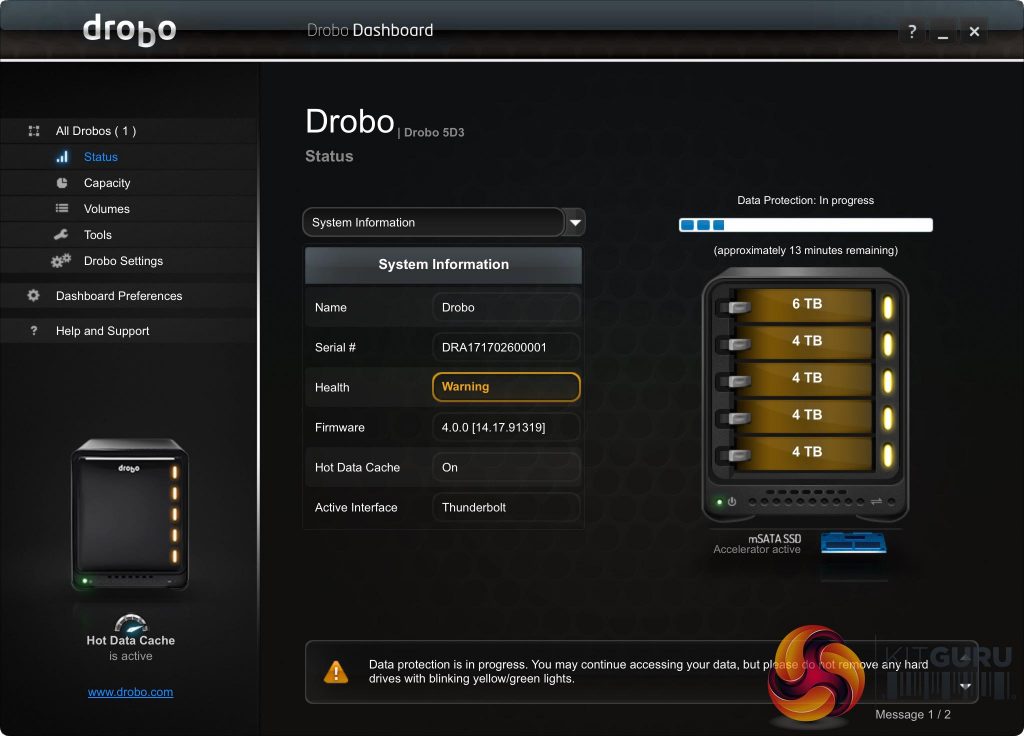
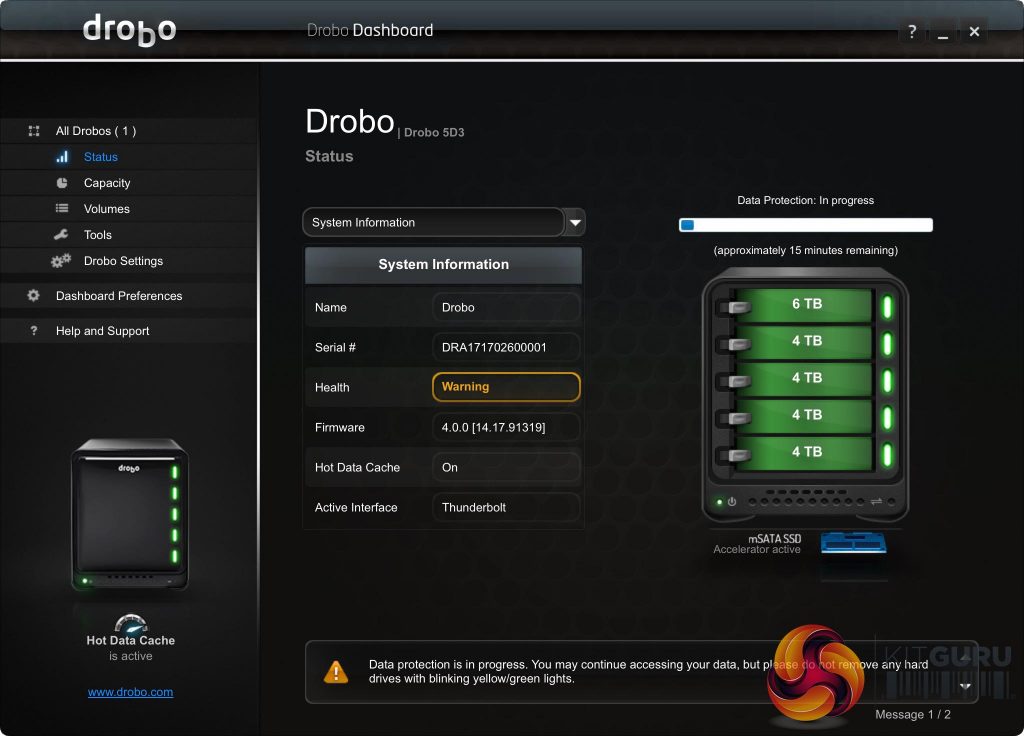
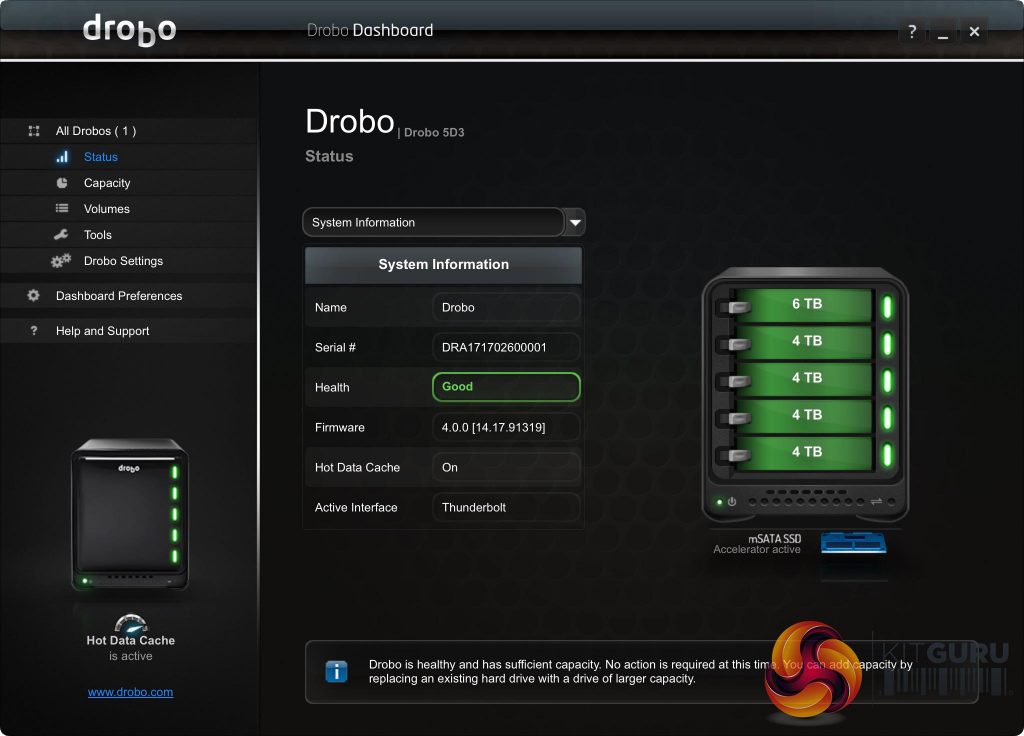
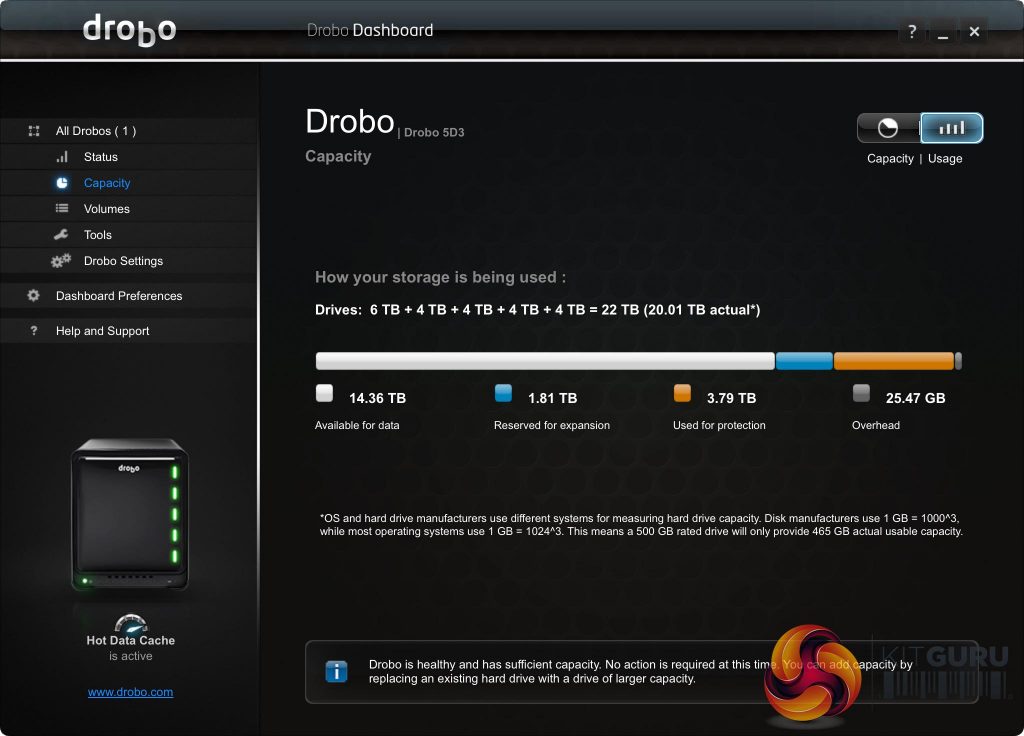

When you say “cooling system is quiet in operation” are you referring to the noise from the unit overall? How quiet is quiet BTW? If I got one of these I would use it in a cabinet in my living room with the rest of my AV gear – BluRay, Tivo, Mac Mini server etc.
Also, how do you feel about the proprietary RAID method used by Drobo? In the past there have been a number of issues and a lot of angry people who have lost data. Their RAID method is now 3 or 4 generations in so I expect that it is fully “debugged.” Do you agree?
There seems to be a lot of inconsistencies in user experience out there with Drobo. On paper it is by far the best solution, but a lot of strongly negative reviews has given me pause. Has Kitguru been using the device continuously and do you still feel this is a strong buy?
In the direct attached storage market.. You’ve got drobo.. you’ve got promise.. and custom enclosures via usb 3.1. (I use all of them)
Promise tech. Pegasus you get super high performance.. but its a standard RAID. so all the drives have to be the same make and model
.. With drobos you lose a little bit of performance but gain flexibility and ease of use.
Custom enclosures you can build it exactly the way you want.. but you will only get usb 3.1 speed.
With drobo or promise, pay for the warranty and the support. Drobo support is very good as long as you keep it up to date and pay for it.
I use them all.. but at home with my photography business, i use drobo. i’ve been using drobo products since their 1st gen 10+ yrs ago. Now i’m using a Drobo 5D. Its been chugging a long for 3 yrs now, no issues other than an occasional bad drive. Its my primary storage.. but its NOT my only storage. I have a onsite and offsite backup too.
Any system can and WILL fail.. you cant just depend on one. Drobo is a great choice as long as you keep the warranty up. Their support has always been very helpful.
The 5d3 is listed with two model numbers DRDR6A21 & DRDR6A31. Any idea what the difference is? The later seems to be the only type available in the UK. I just want to make sure one isn’t configured more for Mac OS, as I’m only on windows. Thanks
the fans are quiet, you get some occasional drive noise.. but you will with any drive.. in a cabnet you’d never know it was there..
The people complaining had no other copy of their data.. any drive system can fail.. these systems are redundant..thats just reckless..
I’ve been running various drobo products for 10 yrs now. I have had better luck with drobo das systems than with promise, g-tech, or lecie
If you use it as recommended, put recommended drives in it.. AND have a backup of some kind, you’ll be fine.
I bought a Drobo 5D3 last week along with 5 Samsung 850 EVO SSD drives. Huge mistake to try Drobo again. I can’t believe how slow it is compared to everything else. Why did they make a thunderbolt 3 version when the maximum speeds you can get are far, far below what thunderbolt 3 offers. The write speed for a 5 x SSD array is much slower than a single drive. Even the read speed for the 5 x SSD array is only 800 MB/s. When I put those same 5 drives in my other device, I get 3-5x better read and write speeds. There is just no excuse for that. If you need performance the Drobo 5D3 will make you sad. It’s not worth wasting a thunderbolt 3 port. https://uploads.disquscdn.com/images/38d7cc3218744efa8cf8ecded856a4eb9af8494ba84bd8eec0bce0889f779d43.png
James, did you figure out why that’s the case, as test show far better performance…
I didn’t see any test that used SSDs inside the Drobo, but my results are definitely faster (at least for reading) than anything I’ve seen posted anywhere.
Many people suggested maybe switching to an “active” thunderbolt 3 cable would improve things. I doubted it would, knowing that the current results were already below what you would expect even with a thunderbolt 2 cable. But I went ahead and spent $75 to get an “active” tb3 cable and re-ran my tests. Guess what? the results did not change at all. The best performance you can hope to get from the Drobo 5D3 is what I have posted above.
I have tested using HDDs, SDDs, USB3 cables, thunderbolt 3 passive and active cables, etc. It’s only slightly slower over USB3 than it is over thunderbolt, which tells you everything you need to know. USB3 is rated at 5 Gbps. Thunderbolt 1 at 10, Thunderbolt 2 at 20, Thunderbolt 3 at 40. But the Drobo doesn’t come close to using even Thunderbolt 2 speeds, so… yeah.
I have tested on my 2017 iMac with a 1GB SSD and 64 GB of RAM. It’s the fastest machine you can get from Apple today. The Thunderbolt 3 active cable is as fast as they come. The Drobo is anything but fast. It doesn’t even utilize enough bandwidth to saturate Thunderbolt 1. That’s just sad.
To say I’m disappointed is an extreme understatement.
James, thank you so much for your reply. For me it’s important, as I’m going to buy myself a new iMac (the full blown one, but not waiting for the pro as that will be overpriced I guess). I’m doing productivity apps and photo (LightRoom – RAW processing) and a bit of video. My intention is to have a 2Tb SDD as main drive, and a fast DAS attached to that as an extension of my main harddrive. (I’ve currently an iMac 2013 with 3 Tb fusion drive, and it’s completely full…). So I don’t intend to use the DAS just for backup purposes. Not eager to consider a NAS either for that, also because I’m using Backblaze as a kind of secondary way of backup, and as you know a DAS can be included in the Backblaze backup, NAS cannot. What alternative would you recommend? Thanks for your insights and advise!
That is my use case as well and precisely why I am so disappointed with the Drobo. I think the fastest DAS you can get right now is the Thunderbolt 3 QNAP stuff, but it’s a lot more expensive than the Drobo. I’m considering changing my workflow so all my “current” and unprocessed photos and Lightroom catalogs live on the internal SSD. As it is, there’s no reason to have the SSDs in the Drobo. The Drobo performs almost as well with fast HDDs… so then I ask myself what I’ll do with the 5 SSDs that I bought for this… and that’s why I may wind up shelling out the money for the QNAP and plugging them in there.
As of now I’m still using the Drobo for my primary storage for photos and Lightroom catalogs. In this configuration my new iMac performs slightly better than my 2013 iMac with the 3 TB fusion drive (sound familiar?). At some point it will upset me enough that I’ll make a change and either buy the QNAP or change my workflow, but so far I’ve just been too busy getting stuff done to deal with it. Hope that helps.
James, but that means if I’d use a QNAP, it’s NAS, so Backblaze won’t include that in their online backup, as they only include DAS, correct?
You can directly connect the QNAP via Thunderbolt 3 just like the Drobo, so it should be considered a DAS, but I can’t guarantee that Backblaze would treat it that way. I don’t use Backblaze, so I don’t know. Check out the QNAP TVS-882ST3-i7-16G-US and see what you think.
James, the QNAP is really very expensive. Think I’m better off buying a Samsung SSD 4TB and attach it over Thunderbolt, and buy a Drobo as the backup device… total cost will be lower, and speed (of the Samsung SSD 4TB higher than the QNAP, no?
James, any comment to what I posted 10 days ago…? Thanks.
I don’t know what Samsung SSD you’re talking about, but unless it involves multiple drives it won’t be as fast as the QNAP. A single SSD drive connected via USB 3.1 will provide almost the same performance as the Drobo, but not close to as fast as the internal SSD or the QNAP (thunderbolt 3).
If you want really fast Thunderbolt 3 external storage, I can recommend the Lacie Bolt 3. It is very expensive. And 3TB gets full quickly. I use it to dump images from my shoots for quick back-up and to keep space on the 1TB disk in my MacBook Pro available for new shoots.